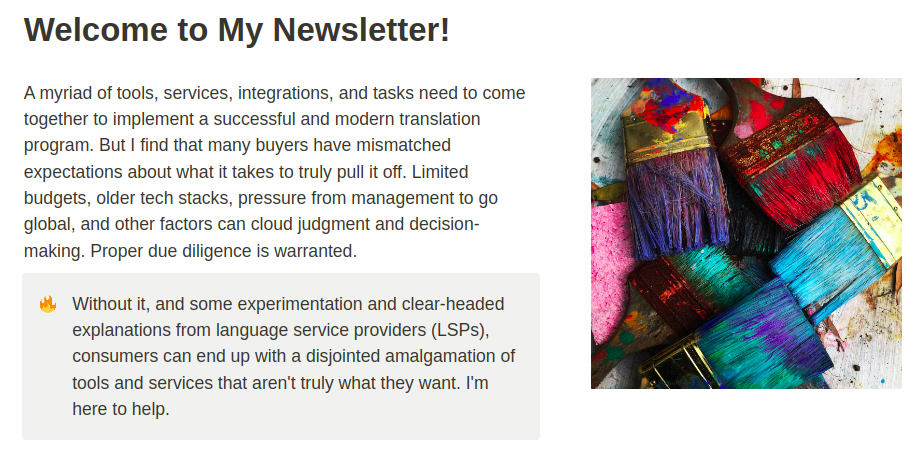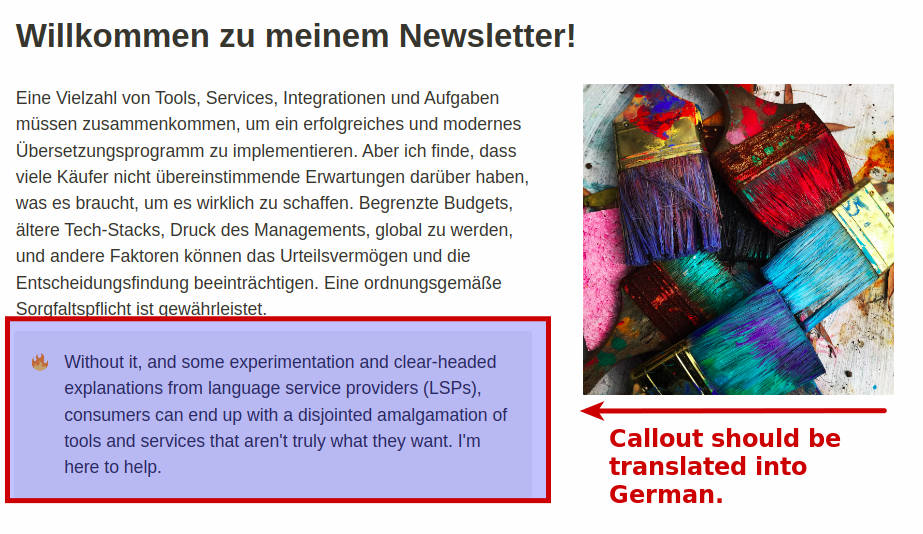Linguistic Quality Assurance

Can't Unsee Website Mistakes
Beth has been meeting with Jill frequently as Jill immerses herself in the language service provider (LSP) vetting project. She provides Jill with xliff files from Wordpress for testing, and explains to Jill the various steps required to make Wordpress translation ready.
Beth otherwise spends her days coding and maintaining the back end of their Wordpress site. But as each interaction with Jill goes by, she gains an awareness of 'localization.' She has to admit, she used to disregard the whole thing. "It's just translation." Now she sees it through the same lens as Jill – as layers of processes, costs, and trust-building exercises with an external vendor.
One day, Beth surfs the web and comes across the landing page for a newsletter publication. The main website's language is English.

There's a language picker in the menu bar. She selects 'German' and—gasp!—stumbles across an error. A callout on the German page still appears in English.

Beth is naturally sensitive about how the Company X website is perceived by its customers. She can't imagine this happening and, in fact, she's a bit shaken because she realizes that Company X is wading into the same waters.
How can we prevent this from happening on our own website? She sends Jill an email:
Just ran across this when reading a blog. There's a paragraph that supposed to be in German, but that is still displaying in English. Thought a concrete example of something like this might help you with the vetting process.
How will the LSP that we ultimately decide to hire prevent this from happeneing?
Best.
Beth
Message Received
Jill ponders this. She's covered a lot of ground so far – glossary and style guide creation, translation, editing, translation memory files. She appreciates that these processes are intended to create content that perfectly fits the target market in terms of linguistic and cultural norms.
But on the other hand, it feels like there is always another workflow step that is important. And unskippable!
Jill brings up quality assurance with the three LSPs that she's in the final stages of vetting. LSP #2's response:
Great example of a website localization mistake.
Our linguists do their work in a translation tool called a translation management system (TMS). The TMS adds great value because it will store all your language assets in one place, which will be visible to the linguists and safeguard several processes against error.
But it has it's limitations.
The editing environment appears as a grid in the case of the TMS that we use. It's not an exact replica of your website. So, our job is not done when we export the edited translation from the TMS. We still have to do an LQA step to catch errors such as the one you shared with us from the blog.
Our senior translators will review the translated webpages to inspect them for errors.
Could we meet one more time to discuss?
Best regards,
LSP #2
First thing Jill does after receiving this email is to Google "TMS workbench" to find a visual example of the 'grid' that LSP #2 is talking about.

It makes sense. The fuzzy match scores in the right column, highlighted glossary terms, parsing of text into short, easy-to-read segments. She can see why the TMS is so important.
At the same time, there's no rich-text markup for the xliff files that Beth submitted to the LSPs for quoting. There's no way around it: to see what the translated page will look like, there does indeed need to be a another workflow step for doing QA.
Side Note on Internal Pressure
Perculating in the background is Diane's eagerness to move forward. In Part 3 - Pricing and Leverage, Jill procured cost estimates from the three LSPs, one of which was enticing. While Jill knows that the per-word price represents many underlying pieces, Diane doesn't have the bandwidth to ascertain tactical-level knowledge. Localization is one of many initiatives that she's managing.
The pressure is on Jill to finish the report and make her recommendations. She senses that the localization manager (LM) role is more cross-functional than she imagined. She needs to manage expectations across the spectrum of internal stakeholders, whether its the management team, the dev team, or otherwise. Jill sends a quick note to Diane politely asking her for her patience.
Quick update. I'm making great progress with the vetting process. While we have received budgetary cost estimates, there are a few more steps I need to confirm before I make recommendations to the management team.
Fully aware of the urgency to get this sorted out. Bear with me! I'll have another update by early next week.
Jill
Current Website Localization Workflow
Setting all that aside, Jill understands that linguistic quality assurance (LQA) comprises a series of steps to make sure that the quality of the output is the highest it can be before it goes live. Jill takes inventory of the workflow steps to localize Company X's Wordpress site to date.
- The content to be translated is pages and posts from the Wordpress site.
- Beth will install a plugin to enable exporting them as source files from Wordpress (Wordpress plugins to be covered in a separate article).
- The source files will be in the xliff format.
- Beth will send them to the down-selected LSP by email attachment.
- The LSP will import the source files into thier translation environment: a TMS equipped with glossaries, translation memories, workflows, style guides, and reference materials.
- The LSP will analyze the source files upon receipt against the translation memory to provide a weighted price per word for the cost estimate.
- Company X will evaluate and approve the quote.
- The LSP will do their work in two human translation steps: 1. translation and 2. editing.
- The LSP will deliver the same xliff files containing completed translations.
- Beth will upload the xliff's to wordpress and confirm that the translations loaded correctly.
...Plus the LQA Step
It's at this point that a linguistic quality assurance (LQA) step enters the picture. Beth will have to upload the xliff files containing the completed translation back to Wordpress and enable the pages for viewing by the language reviewers working for the LSP. She'll also need to provide the list of webpage links to the LSP so that the reviewers can conduct online quality assurance of the translations.
For now, Jill updates the Project Plans with workflow steps that include the LQA process once Beth is done uploading.
- Beth will share the list of links with the LSP.
- The LSP's project manager will write instructions for the reviewers to follow as they evaluate each web page.
- The reviewers will look for layout issues, missing translations, text overruns, or other problems and list them in a Google Sheet as feedback.
- The LSP will take the feedback (if any), implement it in the TMS, and then redeliver the xliff files to Beth.
- Beth will upload them to the Wordpress site and publish them.
In responding to the question of LQA, the three LSPs tell Jill that the LQA step is an additional cost, but at a fraction of the full-word pricing she's received so far. She thinks it's worth it. The LSPs need to update the pricing they previously provided to her.
Finish Line in Sight
With that, Jill sees how the translation project will be executed from start to finish. She's amazed that for such a commoditized industry as translation how each of the LSPs have different approaches to doing business. There's one that she thinks fits Company X's objectives and values for doing business. She's excited to finish up the Project Plan and make her recommendations to Diane, which I will cover in the last installment in the series: Vendor Selection. Coming soon!
Quick Reminder
Here are the roles I refer to throughout the Buyer Series.
Localization Roles
Company X: A business with a Wordpress website and a flagship product called Product Oh Yeah. Both need to be translated.
Jill: The localization manager (LM) working for Company X. Jill's title is 'Content Manager.' She was hired to create and manage content in Wordpress, and she has no previous experience with localization.
Diane: Content Strategy VP at Company X. Appointed to oversee the localization budget. Xander wants to translate the Wordpress website and Product Oh Yeah into French (France), German, and Spanish (US) if the costs fit the initial earmark. If not, then Spanish (US) only.
Seo-Jun: An employee working at Company X's Seoul office. Seo-Jun is a subject matter expert for company content and the QA lead for Korean.
Beth: A Wordpress developer working at HQ for Company X.
Leon: An employee working at Company X's Berlin office. Leon is a subject matter expert for company content and the QA lead for German.
Adalia: An employee working at Company X's headquarters. Adalia is a subject matter expert for company content and the QA lead for Spanish (US).





Member discussion